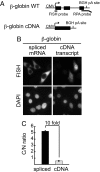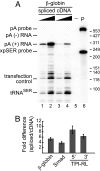Splicing promotes rapid and efficient mRNA export in mammalian cells
- PMID: 18287003
- PMCID: PMC2265164
- DOI: 10.1073/pnas.0800250105
Splicing promotes rapid and efficient mRNA export in mammalian cells
Abstract
The numerous steps in protein gene expression are extensively coupled to one another through complex networks of physical and functional interactions. Indeed, >25 coupled reactions, often reciprocal, have been documented among such steps as transcription, capping, splicing, and polyadenylation. Coupling is usually not essential for gene expression, but instead enhances the rate and/or efficiency of reactions and, physiologically, may serve to increase the fidelity of gene expression. Despite numerous examples of coupling in gene expression, whether splicing enhances mRNA export still remains controversial. Although splicing was originally reported to promote export in both mammalian cells and Xenopus oocytes, it was subsequently concluded that this was not the case. These newer conclusions were surprising in light of the observations that the mRNA export machinery colocalizes with splicing factors in the nucleus and that splicing promotes recruitment of the export machinery to mRNA. We therefore reexamined the relationship between splicing and mRNA export in mammalian cells by using FISH, in combination with either transfection or nuclear microinjection of plasmid DNA. Together, these analyses indicate that both the kinetics and efficiency of mRNA export are enhanced 6- to 10-fold (depending on the construct) for spliced mRNAs relative to their cDNA counterparts. We conclude that splicing promotes mRNA export in mammalian cells and that the functional coupling between splicing and mRNA export is a conserved and general feature of gene expression in higher eukaryotes.
Conflict of interest statement
The authors declare no conflict of interest.
Figures




Similar articles
-
Analysis of mRNA nuclear export kinetics in mammalian cells by microinjection.J Vis Exp. 2010 Dec 4;(46):2387. doi: 10.3791/2387. J Vis Exp. 2010. PMID: 21178962 Free PMC article.
-
Polyadenylation and nuclear export of mRNAs.J Biol Chem. 2019 Mar 1;294(9):2977-2987. doi: 10.1074/jbc.REV118.005594. Epub 2019 Jan 25. J Biol Chem. 2019. PMID: 30683695 Free PMC article. Review.
-
Influenza A Virus NS1 Protein Promotes Efficient Nuclear Export of Unspliced Viral M1 mRNA.J Virol. 2017 Jul 12;91(15):e00528-17. doi: 10.1128/JVI.00528-17. Print 2017 Aug 1. J Virol. 2017. PMID: 28515301 Free PMC article.
-
A Ran-independent pathway for export of spliced mRNA.Nat Cell Biol. 2001 Jan;3(1):97-9. doi: 10.1038/35050625. Nat Cell Biol. 2001. PMID: 11146633
-
Coupling transcription, splicing and mRNA export.Curr Opin Cell Biol. 2003 Jun;15(3):326-31. doi: 10.1016/s0955-0674(03)00048-6. Curr Opin Cell Biol. 2003. PMID: 12787775 Review.
Cited by
-
TPR is required for the efficient nuclear export of mRNAs and lncRNAs from short and intron-poor genes.Nucleic Acids Res. 2020 Nov 18;48(20):11645-11663. doi: 10.1093/nar/gkaa919. Nucleic Acids Res. 2020. PMID: 33091126 Free PMC article.
-
Spatial Organization and Dynamics of Transcription Elongation and Pre-mRNA Processing in Live Cells.Genet Res Int. 2011;2011:626081. doi: 10.4061/2011/626081. Epub 2011 Nov 24. Genet Res Int. 2011. PMID: 22567362 Free PMC article.
-
Human astroviruses: in silico analysis of the untranslated region and putative binding sites of cellular proteins.Mol Biol Rep. 2019 Feb;46(1):1413-1424. doi: 10.1007/s11033-018-4498-8. Epub 2018 Nov 17. Mol Biol Rep. 2019. PMID: 30448895 Free PMC article. Review.
-
Transcriptional regulation of the grape cytochrome P450 monooxygenase gene CYP736B expression in response to Xylella fastidiosa infection.BMC Plant Biol. 2010 Jul 1;10:135. doi: 10.1186/1471-2229-10-135. BMC Plant Biol. 2010. PMID: 20591199 Free PMC article.
-
Regulation of survival gene hsp70.Cell Stress Chaperones. 2012 Jan;17(1):1-9. doi: 10.1007/s12192-011-0290-6. Epub 2011 Aug 28. Cell Stress Chaperones. 2012. PMID: 21874533 Free PMC article. Review.
References
-
- Maniatis T, Reed R. An extensive network of coupling among gene expression machines. Nature. 2002;416:499–506. - PubMed
-
- Gruss P, Khoury G. Rescue of a splicing defective mutant by insertion of an heterologous intron. Nature. 1980;286:634–637. - PubMed
-
- Hamer DH, Leder P. Splicing and the formation of stable RNA. Cell. 1979;18:1299–1302. - PubMed
-
- Hamer DH, Smith KD, Boyer SH, Leder P. SV40 recombinants carrying rabbit β-globin gene coding sequences. Cell. 1979;17:725–735. - PubMed
Publication types
MeSH terms
Substances
LinkOut - more resources
Full Text Sources
Other Literature Sources

